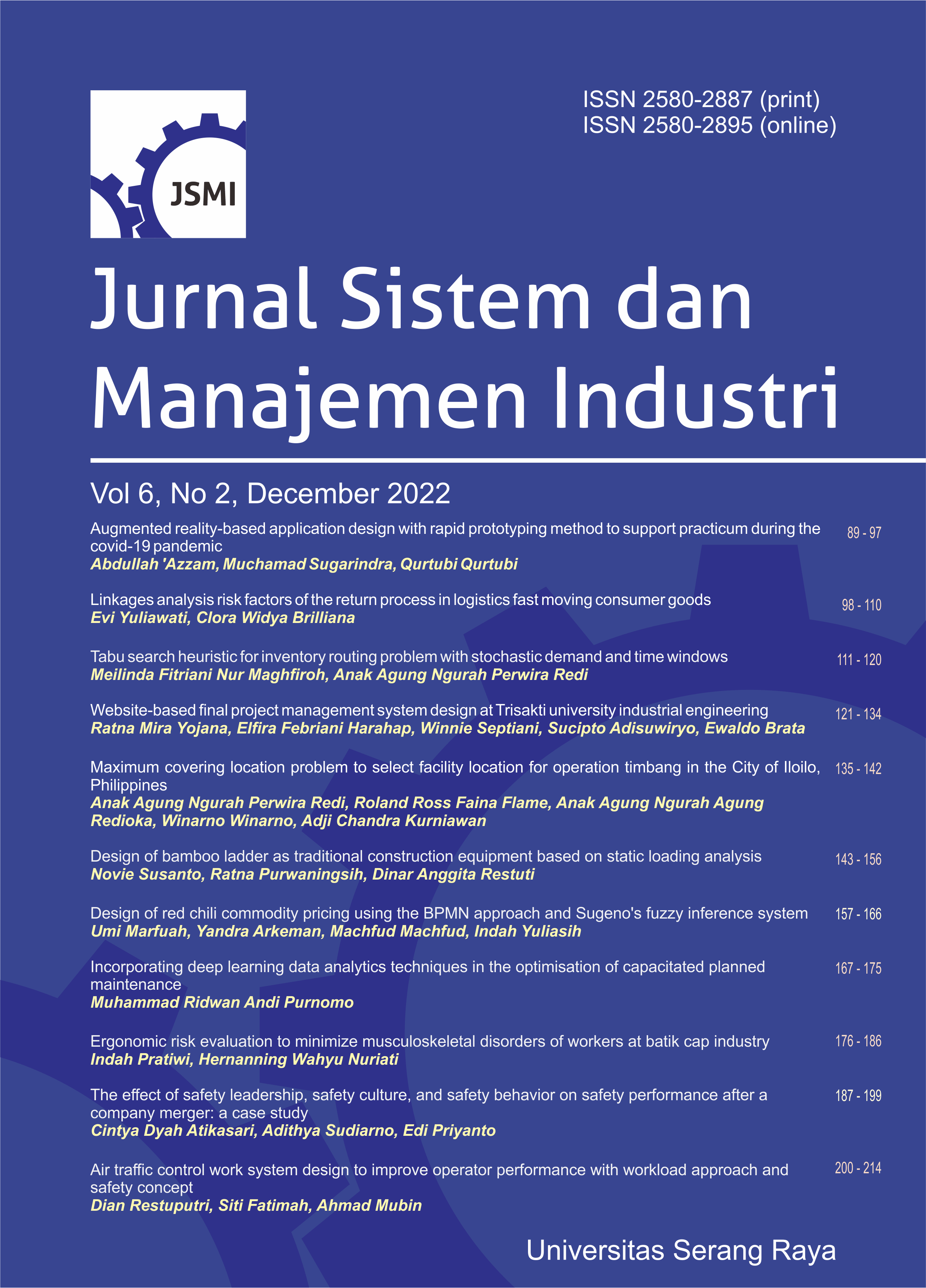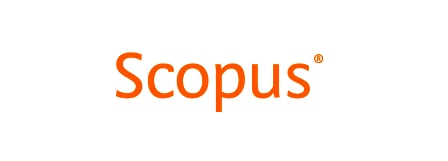Linkages analysis risk factors of the return process in logistics fast moving consumer goods
DOI:
https://doi.org/10.30656/jsmi.v6i2.4736Keywords:
Dematel, FMCG, Return process, Risk factors, SustainableAbstract
This study analyzed the linkage of risk factors in the return process of fast-moving consumer good (FMCG) logistics systems. The risk of returning products due to expired, near expiration, order errors and bad stock (damaged) haunts sustainable supply chains in the industry. In four business processes, warehousing, transport/distribution, productÂion/supply and order processing identified twenty-two risk factors that cause the return process. The decision-making and trial evaluation laboratory (DEMATEL) method helps decision-makers simplify causal relationships between twenty-two complex risk factors. Through the depiction of the matrix and the network relationship map, twelve risk factors entered the dispatcher group, namely risk factors that can affect other risk factors that impact the return process on the FMCG logistics system. The result becomes a reference for decision makers to prioritize risk factors management that have a relationship with other risk factors, because the impact obtained will be maximal.
Downloads
References
C. H. Hsu, A. Y. Chang, T. Y. Zhang, W. Da Lin, and W. L. Liu, ‘Deploying resilience enablers to mitigate risks in sustainable fashion supply chains’, Sustain., vol. 13, no. 5, pp. 1–24, 2021, doi: https://doi.org/10.3390/su13052943.
A. Majumdar, S. K. Sinha, and K. Govindan, ‘Prioritising risk mitigation strategies for environmentally sustainable clothing supply chains: Insights from selected organisational theories’, Sustain. Prod. Consum., vol. 28, pp. 543–555, Oct. 2021, doi: https://doi.org/10.1016/j.spc.2021.06.021.
W. Song, X. Ming, and H. Liu, ‘Identifying critical risk factors of sustainable supply chain management: A rough strength-relation analysis method’, J. Clean. Prod., vol. 143, pp. 100–115, Feb. 2017, doi: https://doi.org/10.1016/j.jclepro.2016.12.145.
V. Mani, A. Gunasekaran, and C. Delgado, ‘Supply chain social sustainability: Standard adoption practices in Portuguese manufacturing firms’, Int. J. Prod. Econ., vol. 198, pp. 149–164, Apr. 2018, doi: https://doi.org/10.1016/j.ijpe.2018.01.032.
X. Xu and J. E. Jackson, ‘Investigating the influential factors of return channel loyalty in omni-channel retailing’, Int. J. Prod. Econ., vol. 216, no. March, pp. 118–132, Oct. 2019, doi: https://doi.org/10.1016/j.ijpe.2019.03.011.
M. P. de Brito and R. Dekker, ‘A Framework for Reverse Logistics’, in Reverse Logistics, Berlin, Heidelberg: Springer Berlin Heidelberg, 2004, pp. 3–27.doi: https://doi.org/10.1007/978-3-540-24803-3_1.
V. D. R. Guide, G. C. Souza, L. N. Van Wassenhove, and J. D. Blackburn, ‘Time Value of Commercial Product Returns’, Manage. Sci., vol. 52, no. 8, pp. 1200–1214, Aug. 2006, doi: https://doi.org/10.1287/mnsc.1060.0522.
N. Janakiraman, H. A. Syrdal, and R. Freling, ‘The Effect of Return Policy Leniency on Consumer Purchase and Return Decisions: A Meta-analytic Review’, J. Retail., vol. 92, no. 2, pp. 226–235, Jun. 2016, doi: https://doi.org/10.1016/j.jretai.2015.11.002.
R. Ramanathan, ‘An empirical analysis on the influence of risk on relationships between handling of product returns and customer loyalty in E-commerce’, Int. J. Prod. Econ., vol. 130, no. 2, pp. 255–261, 2011, doi: https://doi.org/10.1016/j.ijpe.2011.01.005.
J. A. Petersen and V. Kumar, ‘Are Product Returns a Necessary Evil? Antecedents and Consequences’, J. Mark., vol. 73, no. 3, pp. 35–51, May 2009, doi: https://doi.org/10.1509/jmkg.73.3.035.
T. L. Powers and E. P. Jack, ‘Understanding the causes of retail product returns’, Int. J. Retail Distrib. Manag., vol. 43, no. 12, pp. 1182–1202, 2015, doi: https://doi.org/10.1108/IJRDM-02-2014-0023.
Y. Li, L. Xu, and D. Li, ‘Examining relationships between the return policy, product quality, and pricing strategy in online direct selling’, Int. J. Prod. Econ., vol. 144, no. 2, pp. 451–460, 2013, doi: https://doi.org/10.1016/j.ijpe.2013.03.013.
C. Sunil and S. S. ManMohan, ‘Managing Risk to Avoid Supply-Chain Breakdown’, MIT Sloan Manag. Rev., vol. 46, no. 1, pp. 53–61, 2004, [Online]. Available: https://dialnet.unirioja.es/servlet/articulo?codigo=2192240.
M. Elmsalmi and W. Hachicha, ‘Risks prioritization in global supply networks using MICMAC method: A real case study’, in 2013 International Conference on Advanced Logistics and Transport, May 2013, pp. 394–399, doi: https://doi.org/10.1109/ICAdLT.2013.6568491.
W.-W. Wu, L. W. Lan, and Y.-T. Lee, ‘Exploring decisive factors affecting an organization’s SaaS adoption: A case study’, Int. J. Inf. Manage., vol. 31, no. 6, pp. 556–563, Dec. 2011, doi: https://doi.org/10.1016/j.ijinfomgt.2011.02.007.
J.-K. Chen and I.-S. Chen, ‘Using a novel conjunctive MCDM approach based on DEMATEL, fuzzy ANP, and TOPSIS as an innovation support system for Taiwanese higher education’, Expert Syst. Appl., vol. 37, no. 3, pp. 1981–1990, Mar. 2010, doi: https://doi.org/10.1016/j.eswa.2009.06.079.
M. S. Sangari, J. Razmi, and S. Zolfaghari, ‘Developing a practical evaluation framework for identifying critical factors to achieve supply chain agility’, Measurement, vol. 62, pp. 205–214, Feb. 2015, doi: https://doi.org/10.1016/j.measurement.2014.11.002.
S. Chirra and D. Kumar, ‘Evaluation of Supply Chain Flexibility in Automobile Industry with Fuzzy DEMATEL Approach’, Glob. J. Flex. Syst. Manag., vol. 19, no. 4, pp. 305–319, 2018, doi: https://doi.org/10.1007/s40171-018-0195-7.
Q. Deng, X. Liu, and H. Liao, ‘Identifying critical factors in the eco-efficiency of remanufacturing based on the fuzzy DEMATEL method’, Sustain., vol. 7, no. 11, pp. 15527–15547, 2015, doi: https://doi.org/10.3390/su71115527.
D. Diehl, ‘Supply chain risk management – A case study in the fast moving consumer goods industry’, WHU – Otto Beisheim School of Management, 2012. [Online]. Available: https://opus4.kobv.de/opus4-whu/files/138/Diehl_Doreen_WHU_D.
M. Li et al., ‘Risk assessment of supply chain for pharmaceutical excipients with AHP-fuzzy comprehensive evaluation’, Drug Dev. Ind. Pharm., vol. 42, no. 4, pp. 676–684, Apr. 2016, doi: https://doi.org/10.3109/03639045.2015.1075027.
S. Simba, W. Niemann, and A. Agigi, ‘Supply chain risk management processes for resilience : A study of South African grocery manufacturers’, J. Transp. Supply Chain Manag., vol. 11, no. 1, pp. 1–13, 2017, [Online]. Available: https://journals.co.za/doi/abs/10.4102/jtscm.v11i0.325.
M. Giannakis and T. Papadopoulos, ‘Supply chain sustainability: A risk management approach’, Int. J. Prod. Econ., vol. 171, pp. 455–470, Jan. 2016, doi: https://doi.org/10.1016/j.ijpe.2015.06.032.
T. Agnestia and E. Yuliawati, ‘Mitigasi Risiko Limbah Plastik pada Reverse Logistik Network’, J. Res. Technol., vol. VII, no. 1, pp. 93–106, 2021, [Online]. Available: https://journal.unusida.ac.id/index.php/jrt/article/view/365.
W. Torbacki and K. Kijewska, ‘Identifying Key Performance Indicators to be used in Logistics 4.0 and Industry 4.0 for the needs of sustainable municipal logistics by means of the DEMATEL method’, Transp. Res. Procedia, vol. 39, no. 2018, pp. 534–543, 2019, doi: https://doi.org/10.1016/j.trpro.2019.06.055.
M. Abdel-Basset and R. Mohamed, ‘A novel plithogenic TOPSIS- CRITIC model for sustainable supply chain risk management’, J. Clean. Prod., vol. 247, p. 119586, Feb. 2020, doi: https://doi.org/10.1016/j.jclepro.2019.119586.
H. Panjehfouladgaran and S. F. W. T. Lim, ‘Reverse logistics risk management: identification, clustering and risk mitigation strategies’, Manag. Decis., vol. 58, no. 7, pp. 1449–1474, Apr. 2020, doi: https://doi.org/10.1108/MD-01-2018-0010.
E. Fleisch and C. Tellkamp, ‘Inventory inaccuracy and supply chain performance: a simulation study of a retail supply chain’, Int. J. Prod. Econ., vol. 95, no. 3, pp. 373–385, Mar. 2005, doi: https://doi.org/10.1016/j.ijpe.2004.02.003.
I. K. W. Lai and H. C. W. Lau, ‘A hybrid risk management model: a case study of the textile industry’, J. Manuf. Technol. Manag., vol. 23, no. 5, pp. 665–680, Jun. 2012, doi: https://doi.org/10.1108/17410381211234453.
M. A. Moktadir et al., ‘Analysis of risk factors in sustainable supply chain management in an emerging economy of leather industry’, J. Clean. Prod., vol. 283, p. 124641, Feb. 2021, doi: https://doi.org/10.1016/j.jclepro.2020.124641.
B. Gaudenzi and A. Borghesi, ‘Managing risks in the supply chain using the AHP method’, Int. J. Logist. Manag., vol. 17, no. 1, pp. 114–136, Jan. 2006, doi: https://doi.org/10.1108/09574090610663464.
S. Mithun Ali, M. A. Moktadir, G. Kabir, J. Chakma, M. J. U. Rumi, and M. T. Islam, ‘Framework for evaluating risks in food supply chain: Implications in food wastage reduction’, J. Clean. Prod., vol. 228, pp. 786–800, Aug. 2019, doi: https://doi.org/10.1016/j.jclepro.2019.04.322.
G. Guan, Q. Dong, and C. Li, ‘Risk identification and evaluation research on F-AHP evaluation based supply chain’, in 2011 IEEE 18th International Conference on Industrial Engineering and Engineering Management, Sep. 2011, no. PART 3, pp. 1513–1517, doi: https://doi.org/10.1109/ICIEEM.2011.6035447.
R. S. Tibbenâ€Lembke and D. S. Rogers, ‘Differences between forward and reverse logistics in a retail environment’, Supply Chain Manag. An Int. J., vol. 7, no. 5, pp. 271–282, Dec. 2002, doi: https://doi.org/10.1108/13598540210447719.
F. Aqlan and S. S. Lam, ‘Supply chain risk modelling and mitigation’, Int. J. Prod. Res., vol. 53, no. 18, pp. 5640–5656, Sep. 2015, doi: https://doi.org/10.1080/00207543.2015.1047975.
A. Diabat, K. Govindan, and V. V. Panicker, ‘Supply chain risk management and its mitigation in a food industry’, Int. J. Prod. Res., vol. 50, no. 11, pp. 3039–3050, 2012, doi: https://doi.org/10.1080/00207543.2011.588619.
Downloads
Published
Issue
Section
License
All articles in Jurnal Sistem dan Manajemen Industri can be disseminated provided they include the identity of the article and the source of the article Jurnal Sistem dan Manajemen Industri. The publisher is not responsible for the contents of the article. The content of the article is the sole responsibility of the author
Jurnal Sistem dan Manajemen Industri is licensed under a Creative Commons Attribution-NonCommercial-ShareAlike 4.0 International License.
















1.png)
.png)
.png)
.png)


